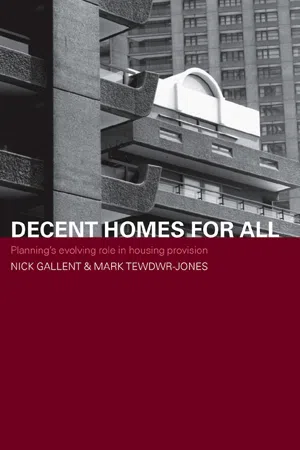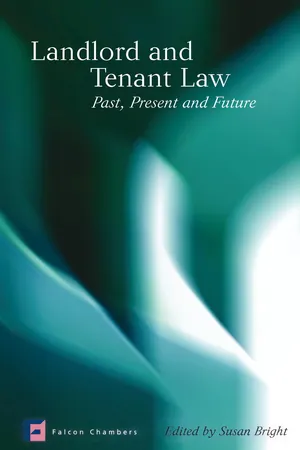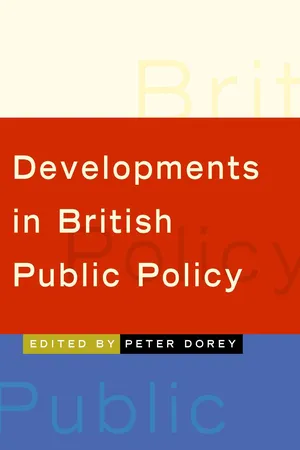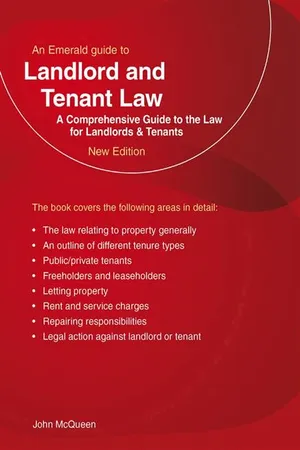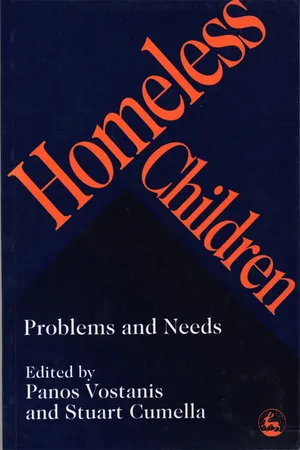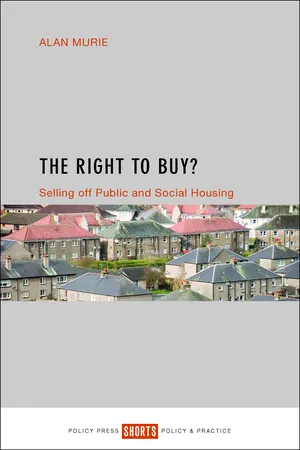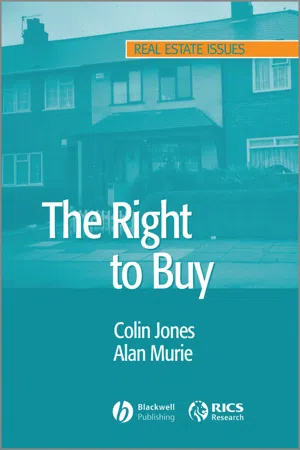History
Housing Act 1980
The Housing Act 1980 was a significant piece of legislation in the United Kingdom that aimed to increase homeownership by allowing council tenants to purchase their homes at a discounted price. This policy, known as the Right to Buy scheme, had a profound impact on the housing market and social structure, leading to a significant increase in owner-occupied housing.
Written by Perlego with AI-assistance
Related key terms
1 of 5
11 Key excerpts on "Housing Act 1980"
- eBook - ePub
Decent Homes for All
Planning's Evolving Role in Housing Provision
- Nick Gallent, Mark Tewdwr-Jones(Authors)
- 2006(Publication Date)
- Routledge(Publisher)
Table 3.1 . Despite the gradual increase in sales throughout the 1960s and 1970s, the obligatory demunicipalisation introduced by the Housing Act 1980 – in the form of an individual Right to Buy – was to produce an unprecedented decline in public sector housing provision (Malpass and Murie, 1987: 98; see also Jones and Murie, 2006). In the immediate aftermath of the Conservative election victory of 1979, the introduction of an obligatory sales policy was seen as the ‘most effective way of expanding homeownership’ (Malpass and Murie, 1987: 99). It also shifted the the emphasis of housing policy onto private rather than public sector solutions.Condemnation of the 1980 legislation on the part of the Government's political opponents was swift; the housing organisation Shelter, claimed that 60 per cent of all local authorities in England and Wales were opposed to the obligatory sale of public housing (including 30 per cent of Conservative-controlled councils). Similarly, ‘the Labour Party Conference of 1979 endorsed the National Executive Committee's statement condemning the Conservative policy of selling council houses, and carried a motion that the next Labour Government would repeal the 1980 Act’ (Balchin, 1981: 137). But despite considerable opposition to the legislation, the new Housing Act was passed through Parliament on 8 August 1980. Eight weeks later, on 3 October, Chapter I of Part I of the Act relating to secure tenants’ RTB came into force (Aldridge, 1980: 4). Our intention now is to consider the background to the 1980 Housing Act and those developments in housing policy that made it possible for the state to essentially drop the well-established idea of public provision of affordable housing. Investment in housing associations created a context in which housing policy was able to move in a different direction (away from public sector intervention), but this does not explain the apparently seismic ideological shift that appeared to occur in 1980. But the Housing Act of that year was not a departure from past thinking (on the part of the Conservatives) but simply the fulfilment of an ideological vision that had been present for a hundred years. Successive Conservative governments had sought to rein-back support for public housing but none had had a mandate for a full withdrawal (or the right plan for such a withdrawal) until 1979. The arrival of the first Thatcher government began a chain of events – a golden age for housing associations followed by their decline and a new reliance on private provision – that set the stage for the current policy context: where public provision is minimum, housing associations (now RSLs) struggle to make any impact in the housing market, and the private sector is called upon to ‘trailblaze’, embracing all manner of new initiatives – sustainable communities, planning gain, planning tariffs, £60,000 homes, affordability targets – aimed at recreating the pool of affordable homes that the country appears to so desperately need, but which has been depleted over the last quarter of a century. - eBook - PDF
Landlord and Tenant Law
Past, Present and Future
- Susan Bright(Author)
- 2006(Publication Date)
- Hart Publishing(Publisher)
20 Exacerbated by the International Monetary Fund’s crackdown on the British economy in the second half of the 1960s. The 1980 Act, however, also introduced the shorthold tenancy, 21 which per-mitted a landlord to recover possession of what was otherwise a protected tenancy simply by compliance with certain formalities. In other words, it started the process of de-regulation of the private rented sector. 22 The period can therefore be seen as the high point in the statutory pro-tection of tenants’ rights, in both senses: as peak and turning. Housing (Homeless Persons) Act 1977 Despite the limitations on its scope, this Act was a major advance. For the first time, the Act created a legal entitlement to housing for those in statu-torily defined classes of housing need. In effect, the Act set legal boundaries to local housing authority discretion to allocate their housing stock accord-ing to their own criteria. No longer did key questions of housing need to be decided according to local schemes. Absent intentionality, the statutorily defined classes of priority need homeless were, by law, to be given prefer-ential treatment (irrespective of what local politicians and officials thought or felt). Issues arising from the legislation became an important and routine part of housing practice from that time on, and continue to do so. Litigation tended to demonstrate a certain ambivalence in the courts. Cases tended to start with a sympathetic result (at the High Court by way of judicial review), but it was not uncommon for this to chill as the case scaled the higher courts. - eBook - PDF
- Peter Dorey(Author)
- 2005(Publication Date)
- SAGE Publications Ltd(Publisher)
(Ball, 1985: 16) It is important to keep this observation in mind when examining housing policy after 1979. Policy developments in this period should be viewed against the long-established basic assumption that the market could and should provide for most people. Government policy throughout the 1980s was dominated by the objective of expanding owner-occupation, and this has remained a priority ever since. Consequently, owner-occupation in Britain has risen from 55 per cent in 1979 to 69 per cent in 2000 (Wilcox, 2002: 91). Almost a third of the growth in owner-occupation since 1980 has been due to the sale of council houses, and for several years during the housing market recession of the early 1980s, the sale of council houses was the main source of growth. On one level, the introduction of a mandatory right for council tenants to buy their homes, coupled with severe cuts in capital available for new building by local authorities, was a stunning departure from past orthodoxies, whereby all governments (since 1919) had Housing Policy 127 regarded local authorities as having a positive role to play in tackling housing problems. The council sector had grown continuously for 60 years; now that process was put into reverse, and over the next 20 years 1.8 million dwellings were sold to individual purchasers, help-ing to reduce local authority renting from 31 per cent in the mid-1970s to 14.6 per cent in 2000 (Wilcox, 2002). Council housing was presented by Ministers and some commentators (Coleman, 1985) as part of the problem, although there was an element of duplicity involved in this stance, because, of course, the enthusiasm of council tenants to buy their houses was itself a tribute to the success of local authorities in building dwellings that were seen as worth buying. - eBook - PDF
Social Services
Made Simple Books
- Tony Byrne, Colin F. Padfield(Authors)
- 2014(Publication Date)
- Made Simple(Publisher)
In the same year part of the Housing Finance Act, 1972, was repealed to allow local authorities to return, within reason, to fixing their own rents (being assisted in this by fresh housing subsidies). Meanwhile, under the Housing Act, 1974, local authorities are empowered to require or encourage, through generous grants, private housing improvements in newly created 'Housing Action Areas'. Finally, under the Com-munity Land Act, 1975, local authorities were empowered to acquire and release land for development. However, with a change of government in 1979, the Community Land Act was repealed (under the Local Government, Planning and Land Act, 1980) and the new decade began with the controversial Housing Act, 1980 (see page 281). Thus do we see that housing policy, somewhat in contrast to other Housing 261 social services, is subject to the ups and downs of the economy and the 'ins and outs' of party politics. This is partly due to the fact that the building industry is a significant element in the government's economic management and partly because housing is substantially within the private sector. The nature of a housing policy The need for a policy arises from the fact that the State now accepts that it has a commitment to see that people are decently housed. The degree of commitment can be gauged partly by crude measures such as the amount of government expenditure devoted to housing or by the quantity of legislation over a period dealing with housing. Apart from overall commitment and degree of priority given to housing, housing policy is concerned with achieving certain objec-tives, not just an adequate overall supply of accommodation, but supply at the right price for people to afford, at an adequate standard and in the right place. - eBook - ePub
- (Author)
- 2015(Publication Date)
- Straightforward Publishing Digital(Publisher)
6
Public Sector-Secure Tenancies
The 1980 Housing Act introduced the right to buy for public sector tenancies and also introduced a measure of protection hitherto absent. The 1985 Housing Act consolidated the 1980 Housing Act. Over the years since its inception, the 1985 Housing Act has been subject to a number of amendments, notably the 1988 Housing Act, which will be discussed later, and which shifted Housing Associations from the public sector to the private sector, but not local authorities. All tenancies granted by local authorities and housing associations before January 15th 1989 are secure tenancies, with the exception of certain tenancies listed below. One specific exception is if a tenancy has been demoted due to anti-social behaviour. Security is lost this way.Secure tenancies
The Housing Act 1985 s 79 (1) defines a secure tenancy as:1) A tenancy under which a dwelling house is let as a separate dwelling is a secure tenancy at any time when the condition described in s 80 and 81 as the landlord condition and the tenant condition is satisfied.There must be a tenancy of a dwelling house which is let as a separate dwelling. Unlike private sector legislation, the 1985 Housing Act does not exclude licences from statutory protection.As far as security is concerned, a secure tenancy, as defined by the 1985 Act, will lose security if one of the conditions creating a secure tenancy is not present. We will be considering the conditions below. One of the main conditions, as we shall see, is that of maintaining the home as an only or principle home. Failure to do this, i.e. by residing elsewhere will render the tenancy non-secure. However, if at a later date, the condition becomes satisfied, i.e. the tenant moves back in then security is retained (Hussey v Camden Council 1995 27 HLR.5 CA). Where possession proceedings are brought, in deciding whether security of tenure has been lost the courts will look at the situation that existed at the expiry of the notice to quit. - eBook - ePub
- Peter Malpass, Rob Rowlands(Authors)
- 2009(Publication Date)
- Routledge(Publisher)
Finally, the continuing decline of the private rented sector came to be seen as inevitable, after the failure of the 1957 Rent Act to revive it, the scandal of Rachmanism, and the work of the Milner Holland Committee (Great Britain, 1965) on the private rented sector in London. The combined effects of lack of investment, slum clearance, sales into owner-occupation—either to sitting tenants or with vacant possession—and, in some cases, municipal or housing association acquisitions seemed to be sounding a death knell for a form of tenure that was considered outdated and inappropriate in a modern world. This was fertile ground for the supporters of housing associations, the ‘voluntary’ housing sector, to expand their role in the acquisition and improvement of older private rented housing and in new building as a source of good-quality rented housing for people in need. The Housing Act, 1974, in effect planned by the Conservative government and enacted by the Labour government elected in 1974, created very favourable conditions for the future growth of a generously subsidised, and what would now be termed a ‘reformed’ and ‘modernised’, voluntary housing movement.Tenure was important as a framework for housing policy and, despite the official encouragement of local authorities to take a comprehensive approach to the formulation and implementation of housing policies at local level, this advice, though emanating from central government, was generally not followed at national level. Different legal and financial regimes applied to each of the three main tenures; standards for both existing and new housing differed between tenures; levels of council-house building were often determined as a residual of what was being built for owner-occupation; and notwithstanding the adoption of ‘fair rents’ as a principle to be applied to the council sector from 1972 (a system introduced by Labour in 1965 for the independent determination of rents in the private rented sector), the suggestion that this would provide ‘a fairer choice between owning a home and renting one’ or ‘fairness between one citizen and another in giving and receiving help towards housing costs’ (Great Britain, 1971: 1) was plainly wrong. For example, the more tenants earned, the less they received in rent rebate; while the more owner-occupiers earned, the more they received in mortgage interest tax relief (Murie et al - eBook - PDF
- David Mullins, Alan Murie(Authors)
- 2017(Publication Date)
- Red Globe Press(Publisher)
Housing Green Paper : set direction for a number of housing reforms including option appraisals, ‘Arm’s-Length Management Organizations and Private Finance Initiative options to meet, the Decent Homes Standard, rent restructuring, Housing Benefit reform and Choice-Based Lettings. 2001 Housing (Scotland) Act : Major legislation covering homelessness and allocation of housing, Scottish secure tenancies, Right to Buy, tenant participation, regulation of social landlords, housing management, strategic housing functions and private sector grants. 71 Source : Data from HMSO UK legislation website. 2002 Commonhold and Leasehold Reform Act : established system of registration for commonhold, right to manage and collective management by tenants of flats. Homelessness Act : required local authorities to produce homelessness strategies. Amended priority needs groups to include 16–17 year olds. Repealed the 1996 Housing Act provisions that limited the period for which duty was owed to the homeless. Abolished the duty to maintain housing registers. Regulatory Reform (Housing Assistance) England and Wales Order : required local authorities to publish private sector renewal strategies. Repealed private sector grants and loans provisions, enabled local authorities to assist housing renewal directly or through third parties such as housing associations and private sector loan finance. 2003 Sustainable Communities Plan : gave higher profile to housing policy and responded to regional disparities. Led to the establishment of Regional Housing Boards, Regional Housing Strategies, additional investment in new homes in the South and the establishment of Housing Market Renewal Areas in parts of the Midlands and the North. Anti-Social Behaviour Act : required social landlords to have policies on antisocial behaviour, introduced new considerations in respect of possession proceedings on the conduct of tenants, parenting orders and antisocial behaviour orders. - eBook - PDF
Housing Policy Analysis
British Housing in Culture and Comparative Context
- Stuart J. Lowe(Author)
- 2017(Publication Date)
- Red Globe Press(Publisher)
156 6 Tenure Re-Structuring Introduction Britain underwent a dramatic restructuring of its housing tenure pattern during the course of the twentieth century. Why this should be the case requires explanation. Its significance is not only in the transfor-mation of property rights and financial gains and losses in the housing stock but also to wider society. As Kemeny has shown, different config-urations of housing tenure impact on urban form and welfare state development. ‘Home owning societies’, for example, are more likely to have private insurance-based, workfare forms of welfare provision (Kemeny, 1981). The scale of tenure restructuring in Britain over the CHAPTER AIMS • To explain how Britain became a home owning society during the twentieth century • To use an historical institutionalist approach to understanding the progress of policy change • To point to the critical moments in the development of housing policy • To account for the impact of the two world wars on the provision of housing • To explain the reasoning behind the deep residualization of rental housing in the last few decades of the twentieth century. Tenure Re-Structuring 157 twentieth century should make us vigilant for evidence of these wider issues. Looked at in this way ‘housing’ is not simply an accumulated stock of dwellings but is also a source, or at least a catalyst, to social change. It is something of a paradox that such an immovable entity as a stock of dwellings could be the focal point of dynamic social change. The explanation and development of this issue is discussed in detail in Chapter 10. Here we are concerned with why Britain transformed during the course of the twentieth century from a nation of private renters to a nation of homeowners. - eBook - PDF
Homeless Children
Problems and Needs
- Panos Vostanis, Stuart Cumella(Authors)
- 1999(Publication Date)
- Jessica Kingsley Publishers(Publisher)
chapter 8 Effects of Changes in Housing Legislation Pat Niner This chapter looks at aspects of housing policy and law as they affect home-less families in England and Wales. It looks first at homelessness legislation, including recent changes, and explores how this essentially ‘defines’ home-lessness. It then describes some of the practical outcomes of the implementation of homelessness policy for homeless families, and finally identifies some important issues for the future. Homelessness legislation in England and Wales Before 1977, homelessness was not strictly a ‘housing’ matter – welfare authorities had a duty to provide temporary accommodation ‘for persons who are in urgent need thereof, being need arising in circumstances which could not reasonably have been foreseen or in such other circumstances as the authority may in a particular case determine’ (National Assistance Act 1948, section 21(1)). There was no complementary duty to provide any form of permanent housing for homeless people, and council housing (the main source of rented housing for poorer and needy people) was under the control of separate housing authorities. Despite central government urges towards greater sharing of responsibilities between local social services (formerly welfare) and housing authorities, the picture was generally very variable over the country, and basically highly unsatisfactory with families being sepa-rated in temporary accommodation and children at risk of being taken into care simply because their parents lacked accommodation. The introduction of the Housing (Homeless Persons) Act 1977 – later consolidated into Part III of the Housing Act 1985 – changed all this. Very 97 broadly, Part III placed on local housing authorities a duty to secure accommodation for persons who were homeless and who had not become homeless intentionally and who were in priority need. - eBook - ePub
The Right to Buy?
Selling off public and social housing
- Murie, Alan, Alan Murie(Authors)
- 2016(Publication Date)
- Policy Press(Publisher)
Before 1979 the demand for discretionary house sales policies was less evident in Scotland than England. In the postwar period, housing in Scotland was the responsibility of the Scottish Office, and its approaches did not mirror those in England. Until 1979, a general consent for council house sales had only operated in Scotland between 1972 and 1974 (Scottish Development Department, 1972, 1974). This does not mean that the Scottish Office did not approve individual cases, and its capacity to assess these was arguably greater than in England. Between 1970 and 1973, 62 Scottish councils sold a total of 892 council dwellings; only 19 councils had sold 10 or more dwellings, and 31% of all sales had been in Edinburgh. The general consent generated 6,972 sales between 1973 and 1979.The Housing Tenants’ Rights Etc Act (Scotland) 1980 enacted the same Right to Buy proposals as England and Wales, but following devolution, in 1998 the Scottish Parliament and government made changes because of the pressures that the Right to Buy was placing on the social housing sector (Jones and Murie, 2006, pp 42-46). The Housing (Scotland) Act 2001 did not alter arrangements for existing tenants who retained a Preserved Right to Buy with a qualifying period of two years and discounts of 60% for houses and 70% for flats. For new or transferring tenants (taking up a tenancy after 30 September 2002) introduced a ‘Modernised’ Right to Buy with less generous discounts (starting at 20% after 5 years and rising by 1% for every additional year of tenancy to a maximum of 35% after 20 years and with a cash maximum of £15,000). The Modernised Right to Buy would also apply to most housing association tenants after 10 years, although housing associations could apply to the Scottish government to extend this period.The ‘Modernised’ Right to Buy introduced a common set of rights, within a single standard secure tenancy for all social sector tenants, introduced at the same time. Tenants who already had the Right to Buy had their existing rights ring-fenced, and the longer qualifying period and lower discounts (with the same rates for flats and houses) only applied to new tenants. The Housing (Scotland) Act 2001 also introduced a procedure for the identification and designation of pressured areas where the Right to Buy would be suspended, to safeguard the continued availability of social rented housing. The thinking behind these changes was that the Right to Buy had been operating in isolation or possibly at variance with other policies. Compared with other policies (including cash incentives for tenants to move elsewhere to buy), the Right to Buy was expensive and it could cause problems in some areas. The conclusion was that it should be ‘rebalanced rather than removed’, to meet the aspirations of low-income households and the objectives of communities (Jones and Murie, 2006). - eBook - PDF
The Right to Buy
Analysis and Evaluation of a Housing Policy
- Colin Jones, Alan Murie(Authors)
- 2008(Publication Date)
- Wiley-Blackwell(Publisher)
Table 4.1 indicates the tenure structure of the different parts of the United Kingdom in 1981 and compares these with later years. In the UK in 1981 29% of the housing stock was in the ownership of local authorities and new towns and some 2% was owned by housing associations. The largest tenure was home ownership, accounting for 58% of the stock. The highest rates of home ownership were in Wales (62%) and England (60%), with Scotland significantly behind with 36% of the stock in home owner-ship and 52% owned by local authorities. By 2001 this position had changed considerably. The owner-occupied sector had expanded by at least 10 per-centage points everywhere and the expansion had been 27 percentage points in Scotland. The council housing stock in 1980 was a varied one. However, the 6.5 mil-lion dwellings in the stock were predominantly traditionally built houses with gardens with a smaller proportion of flats and even fewer high rise blocks. Local authorities had built popular dwellings to high standards and they were maintained at high levels. The quality of what was offered under the Right to Buy was generally very high and the popularity and value of the housing stock was also high. For tenants in such good quality dwellings the opportunity to purchase at a substantial discount was attrac-tive. The research evidence suggests that the households living in the best Unequal Opportunities, Time and Place 53 properties were often those who qualified for high levels of discount. They were households in the middle of the family lifecycle, in their 40s and 50s. More affluent tenants qualified for the largest discounts and these applied to the best quality dwellings. The formula generated high levels of sale, especially amongst this group of tenants and among the better quality properties (Forrest and Murie 1990a).
Index pages curate the most relevant extracts from our library of academic textbooks. They’ve been created using an in-house natural language model (NLM), each adding context and meaning to key research topics.
